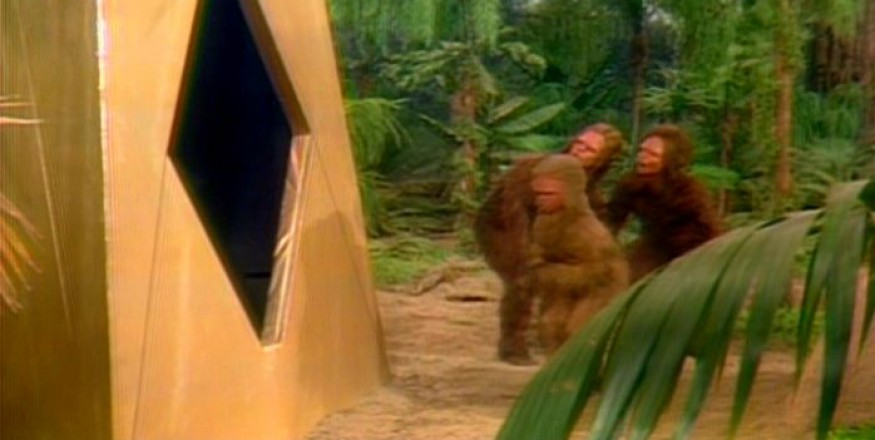The briefing took place in a large rectangular chamber that could hold 100 people with ease. It was equipped with the latest optical and electronic displays and would have looked like a model conference room but for the numerous posters, pinups, notices, and amateur paintings which indicated that it was also the center of the local cultural life. Marshall was particularly struck by a collection of signs, obviously assembled with tender loving care, which carried messages like PLEASE KEEP OFF THE GRASS....NO PARKING ON EVEN DAYS.....PROIBIDO FUMAR...TO THE BEACH....CATTLE CROSSING...SOFT SHOULDERS and DO NOT FEED THE ANIMALS. If these were genuine--as they surely seemed to be--their importation from Earth had cost a king's ransom. There was a moving defiance about them; on this hostile world, men could still joke about the things they had been forced to leave behind....and which their children would never miss.
A crowd of forty or fifty people awaited Marshall, and everyone rose politely as he entered behind the Administrator. As he nodded at several familiar faces, Marshall sat down in the front row, while the Administrator ascended the rostrum and looked round his audience.
"Ladies and gentlemen," Halvorsen began, "I don't have to tell you that this is a very important occasion. We are delighted to have Dr. Richard Marshall with us. We all know him by reputation, and many of us are personally acquainted with him. He has just completed a special flight from Earth to be here, and before the briefing he has a few words for us. Dr. Marshall."
Marshall walked to the lectern amid a tidal wave of polite applause, surveyed the audience with a smile, and said: "Thank you---I only want to say this. The President has asked me to convey his appreciation of your---outstanding work, which we hope the world will soon be able to recognize. I'm quite aware," he continued carefully, "that some of you---maybe most of you---are anxious that the present veil of secrecy be withdrawn; you would not be scientists if you thought otherwise." He caught a glimpse of Dr. Michaels, whose face was creased in a slight frown which brought out a long scar down his right cheek....presumably the aftermath of some accident in space. The geologist, he was well aware, had been protesting vigorously against what he called this "cops and robbers nonsense."
"I remind you," Marshall continued, "that this is a quite extraordinary situation. We must be absolutely sure of our own facts; if we make mistakes now, there will be no second chance---so please be patient a little longer. Those are the wishes of the President.
"That's all I've got to say. Now I'm ready for your report."
He walked back to his seat; the Administrator said, "Thank you very much, Dr. Marshall," and nodded, rather brusquely, to his Chief Scientist. On cue, Dr. Michaels walked up to the rostrum, and the lights faded out.
A photograph of the Moon flashed onto the screen. At the very center of the disk was a brilliant white crater ring, from which a striking pattern of rays fanned out. It looked exactly as if someone had hurled a bag of flour at the face of the Moon, and it had spattered out in all directions.
"This is Tycho," said Michaels, pointing to the central crater. "On this vertical photograph Tycho is even more conspicuous than when seen from Earth, then it's rather near the Moon's edge. But observed from this viewpoint---looking straight down from 1,000 miles up---you can see how it dominates an entire hemisphere."
He let Marshall absorb this unfamiliar view of a familiar object, then went on: "During the past year we have been conducting a magnetic survey of this region, via a low-level satellite. It was completed only last month, and this is the result---the map that started all the excitement."
Another picture flashed on the screen; it looked like a contour map, though it showed magnetic intensity, not heights above seal level. For the most part, the lines were roughly parallel and spaced well apart; but in one corner of the map they became suddenly packed together, to form a series of concentric circles---like a drawing of a knothole in a piece of wood.
Even to untrained eyes, it was clear that something odd had happened to the Moon's magnetic field in this region; and in big letters across the bottom of the map were the words: ANOMALIA DA LUA DE TYCHO (ALT-1). Stamped on the top right was CLASSIFICADO.
"At first we thought it might be an outcropping of magnetic rock, but all the geological evidence was against that. And not even a big nickel-iron meteorite could make a field as intense as this; so we decided to have a look.
"The first party found nothing---just the usual level terrain, buried beneath a very thin layer of moon-dust. They sank a drill in the exact center of the magnetic field to get a core sample for study. 20 feet down, the drill stopped. So the survey party began to dig---not an easy job in spacesuits, I assure you.
"What they found brought them back to Base in a hurry. We sent out a bigger team, with better equipment. They excavated for two weeks---and you know the rest of the story."
The darkened assembly room became suddenly hushed and expectant as the picture on the screen changed. Though everyone had seen it many times, there was not a person who failed to crane forward as if hoping to find new details. On Earth and Moon, less than one hundred people had thus far been allowed to set eyes on this photograph.
It showed a man in a bright red and yellow spacesuit standing at the bottom of an excavation and supporting a surveyor's rod marked off in tenths of a meter. It was obviously a night shot, and might've been taken anywhere on the Moon or Mars. But until now no planet had ever produced a scene like this.
The object before which the spacesuited man was posing was a pyramid-like obelisk made of polished gold material, about ten feet high and twelve feet wide: it reminded Marshall, somewhat ominously, of a giant tomb. Perfectly sharp-edged and symmetrical, it was so shiny it seemed to have annihilated the darkness surrounding it; there was no surface detail at all. It was impossible to tell whether it was made of stone or metal or plastic---or some material altogether unknown to man.
"AMT-1," Dr. Michaels declared, almost reverently. "It looks brand new, doesn't it? I can hardly blame those who thought it was just a few years old, and tried to connect it with the third Indian Expedition back in '09. But I never believed that---and now we've been able to date it positively, from local geological evidence.
"My colleagues and I, Dr. Marshall, will stake our reputations on this. AMT-1 has nothing to do with the Indians. Indeed, it's got nothing at all to do with the human race---for when it was buried, there were no humans.
"You see, it is approximately three million years old. What you are now looking at is indisputable evidence of intelligent life beyond the Earth!"
ns 15.158.61.5da2





















